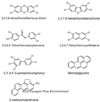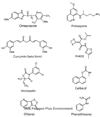The search for endogenous activators of the aryl hydrocarbon receptor
- PMID: 18076143
- PMCID: PMC2572005
- DOI: 10.1021/tx7001965
The search for endogenous activators of the aryl hydrocarbon receptor
Abstract
The primary design of this perspective is to describe the major ligand classes of the aryl hydrocarbon receptor (AHR). A grander objective is to provide models that may help define the physiological activator or "endogenous ligand" of the AHR. We present evidence supporting a developmental role for the AHR and propose mechanisms by which an endogenous ligand and consequent AHR activation might be important during normal physiology and development. From this vista, we survey the known xenobiotic, endogenous, dietary, and "unconventional" activators of the AHR, including, when possible, information about their induction potency, receptor binding affinity, and potential for exposure. In light of the essential function of the AHR in embryonic development, we discuss the candidacy of each of these compounds as physiologically important activators.
Figures
References
-
- Mimura J, Fujii-Kuriyama Y. Functional role of AhR in the expression of toxic effects by TCDD. Biochim Biophys Acta. 2003;1619:263–268. - PubMed
-
- Wilson CL, Safe S. Mechanisms of ligand-induced aryl hydrocarbon receptor-mediated biochemical and toxic responses [see comments] Toxicologic Pathology. 1998;26:657–671. - PubMed
-
- Nebert DW, Puga A, Vasiliou V. Role of the Ah receptor and the dioxin-inducible [Ah] gene battery in toxicity, cancer, and signal transduction. Ann N Y Acad Sci. 1993;685:624–640. - PubMed
-
- Schlede E, Kuntzman R, Haber S, Conney AH. Effect of enzyme induction on the metabolism and tissue distribution of benzo(alpha)pyrene. Cancer Res. 1970;30:2893–2897. - PubMed
-
- Levin W, Conney AH. Stimulatory effect of polycyclic hydrocarbons and aromatic azo derivatives on the metabolism of 7,12-dimethylbenz(alpha)anthracene. Cancer Res. 1967;27:1931–1938. - PubMed
Publication types
MeSH terms
Substances
Grants and funding
LinkOut - more resources
Full Text Sources
Other Literature Sources
Molecular Biology Databases
Research Materials






